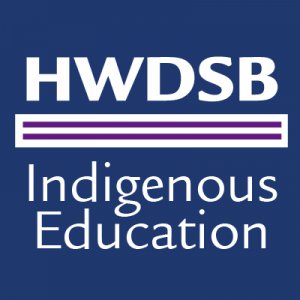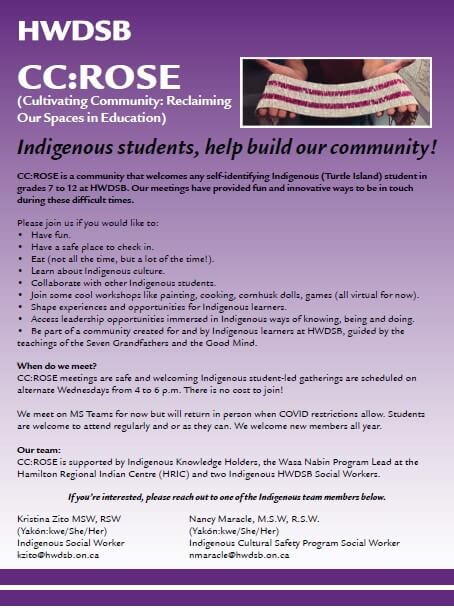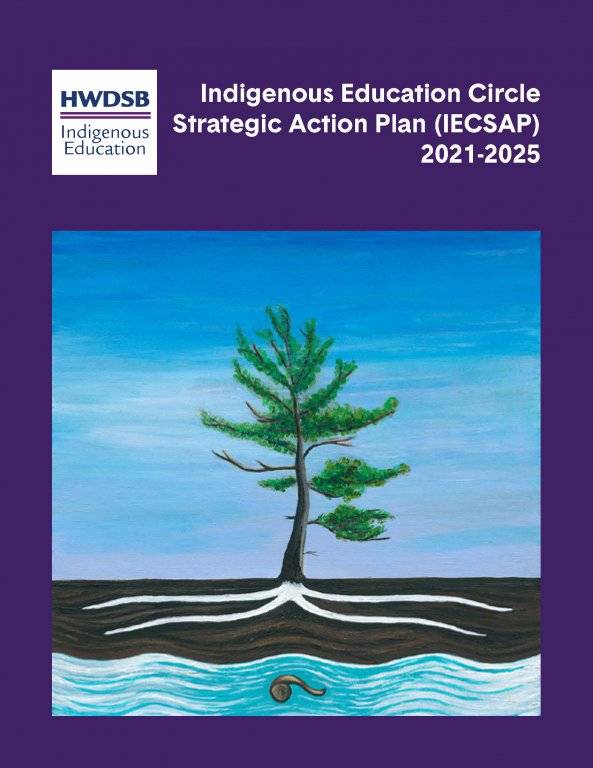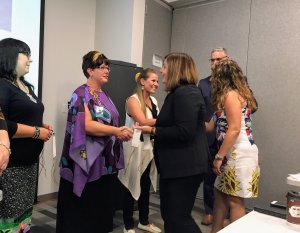
 Land Acknowledgement
Land Acknowledgement
Hamilton-Wentworth District School Board acknowledges our presence on ancestral Anishinaabe and Haudenosaunee Confederacy land as determined by the Dish with One Spoon treaty.
The intent of this agreement is for all nations sharing this territory to do so responsibly, respectfully and sustainably in perpetuity.
We respect the longstanding relationships with the local Indigenous communities, the Mississaugas of the Credit First Nation and the Six Nations of the Grand River.
Contact
[email protected]
20 Education Court Hamilton L9A 0B9 (905) 527-5092
Our Work
At HWDSB, we are honoured to work with community partners to meet the needs of Indigenous students. We strive to weave Indigenous perspectives into curriculum for all students, as well as support the achievement of First Nation, Métis and Inuit students.
View our Indigenous Education Circle Strategic Action Plan (IECSAP) 2021-2025.
 Saaswin Kendaasiwin “Nest of Learning”
Saaswin Kendaasiwin “Nest of Learning”
Tsi Nón:we Konttsí’nahkónnis “Where they make their nests
The Learning Nest
Indigenous Cultural Safety
A culturally immersive learning pilot offered at Hamilton-Wentworth District School Board
Our goal
The Learning Nest is a culturally immersive Indigenous learning pilot offered to learners who self-identify as Indigenous, First Nations (status and non-status), Inuit and Métis (grades 9-12).
In the Learning Nest classroom, Indigenous ways of knowing, being and doing are respected, valued and prioritized. The Learning Nest is a key piece of the ongoing development of an Indigenous Cultural Safety framework. Indigenous learners will see Indigenous knowledge reflected in the space, content and learning experiences.
The Learning Nest experience includes:
- A variety of credit-earning learning experiences, teachings, language and participation in cultural activities and observances
- Working cooperatively with learners, families and caregivers to ensure holistic health and well-being by emphasizing an asset-based model of Indigenous student success
- Holistic well-being plans and bridging to ‘next steps’ and/or life stage, respecting the unique needs and goals of the learner
How
Our team adheres to the following definition of Indigenous Cultural Safety:
Indigenous Cultural Safety is the development, implementation, maintenance and (ongoing) evaluation of education models that reflect the needs of the Indigenous community of Hamilton while being respectful of the 94 Truth and Reconciliation Commission Calls to Action. This includes but is not limited to the teachings found within the Haudenosaunee teachings of the Great Law of Peace, which outlines three guiding principles:
- Peace – healthy mind and healthy body
- Power – harmonious, non-violent unity
- Good mindedness – justice between people and justice between nations
These principles are followed with the understanding that all decisions are made in the best interest of the ‘faces yet to come,’ meaning we begin the decision-making process by considering the best interest of our most vulnerable, the unborn, then the babies, then the crawling ones, then the children and so on…
We also use the following as part of our guide, the Anishinaabe teachings of the Three Fires model of past, present and future generations, the Seven Grandfather Teachings: Bravery, Honesty, Humility, Love, Respect, Truth and Wisdom, and the prophecy of the current generation whom represent the 8th Fire.
We approach the establishment of the Learning Nest from the perspective of a Cultural Safety model: returning to the village-model of caring for our children, educating them, displacing deprivation of identity with rich cultural teachings, based on our Indigenous worldview.
Why now?
This is a time of Reconciliation. The Learning Nest pilot is rooted in the concepts of “Respect, Relevance, Reciprocity and Responsibility” (Kirkness and Barnhardt 2001) and aims to increase the experiences of safety and wellness, while providing a high standard of excellence for Indigenous learners in education.
We are committed to ensuring that each learner, their families and or caregivers have a solid understanding of the roles and responsibilities for all within this
unique and culturally immersive educational experience.
Indigenous Education Team
You are welcome to learn more about Indigenous Education and/or Indigenous Cultural Safety at HWDSB.
Learners, families/caregivers, staff and the community may contact us directly via email or by phone.
NOTE: If you are calling on behalf of a learner, please ensure you have secured consent of the learner and or parent/guardian.
Jolene John, Indigenous Education Lead [email protected]
Kristina Zito, Indigenous System Social Worker [email protected]
20 Education Court Hamilton L9A 0B9 (905) 527-5092 x2119
[email protected]
CC:ROSE
 CC:ROSE (Cultivating Community: Reclaiming Our Spaces in Education) is a community that welcomes any self-identifying Indigenous (Turtle Island) student in grades 7 to 12 at HWDSB. Our meetings have provided fun and innovative ways to be in touch during these difficult times.
CC:ROSE (Cultivating Community: Reclaiming Our Spaces in Education) is a community that welcomes any self-identifying Indigenous (Turtle Island) student in grades 7 to 12 at HWDSB. Our meetings have provided fun and innovative ways to be in touch during these difficult times.
Please join us if you would like to:
- Have fun.
- Have a safe place to check in.
- Eat (not all the time, but a lot of the time!).
- Learn about Indigenous culture.
- Collaborate with other Indigenous students.
- Join some cool workshops like painting, cooking, cornhusk dolls, games (all virtual for now).
- Shape experiences and opportunities for Indigenous learners.
- Access leadership opportunities immersed in Indigenous ways of knowing, being and doing.
- Be part of a community created for and by Indigenous learners at HWDSB, guided by the teachings of the Seven Grandfathers and the Good Mind.
Learn more in our flyer.
Indigenous Education Circle
Second pane content
FNMI Community Advisory Committee
Please see our calendar of Board meetings to learn more about this advisory committee.
Principals representing all 102 schools at HWDSB received symbolic, beaded wampum belts Sept. 13, 2017, in a ceremony that highlighted the Board’s commitment to improve relationships with Indigenous people, knowledges and practices.
The Dish with One Spoon Wampum Belt, to be displayed at each school, represents a treaty relationship between the Haudenosaunee Confederacy and Anishnaabe with respect to sharing the land and resources therein.
Schools and departments will use the wampum as a teaching and learning tool, agreeing to keep it visible, accessible and safe for all to use; they may work with Indigenous staff or community members to broaden understanding and use of the wampum.
“Thank you for continuing to push us and lead us,” Director of Education Manny Figueiredo said at a meeting of principals. HWDSB accepted a wampum at the Board level in June, 2017, and has adopted a new community-vetted Land Acknowledgement that is said before meetings.
HWDSB’s commitment to Indigenous education emerges from a context that has seen Indigenous knowledge historically excluded and marginalized in Canada. Ontario has committed to working with Indigenous partners in education, with a focus on closing the achievement gap between Indigenous and non-Indigenous students.
HWDSB supports the various Indigenous educational initiatives, including:
The Aboriginal Stay in School Initiative (NYA:WEH)
Funded through community grants, NYA:WEH features Indigenous youth workers supporting Indigenous students.
Strengthening Hamilton's Aboriginal Education (SHAE)
What is SHAE
Strengthening Hamilton’s Aboriginal Education (SHAE) is a partnership between Hamilton-Wentworth District School Board (HWDSB) and Hamilton Regional Indian Centre (HRIC).
This alternative education program provides an opportunity for First Nations, Metis, and Inuit students to learn through community and cooperative education opportunities that value Indigenous ways of knowing, being, and doing. SHAE’s goal is to encourage Indigenous student success and wellness while assisting students in obtaining their Ontario Secondary School Diplomas. The program serves Indigenous students by providing a caring, supportive, and non-judgmental environment. The priority of SHAE is safety with zero tolerance for violence or bullying.
Unlike other HWDSB programs, the SHAE classroom is situated at the HRIC, providing students with easier access to the various programs the HRIC offers. In the SHAE classroom, the program is supported by a teacher, an education assistant, a program coordinator, and a social worker. However, the support extends past the teaching staff. Community members, Elders, Knowledge Keepers, parents and families, Indigenous organizations, and many more play an important part in supporting students and their well-being.
What is the process for SHAE?
- Families interested in SHAE can request a class tour via email to discuss if the program can meet their needs. Students must be registered with HWDSB at their home school.
- Students or families can contact their school’s guidance department or social worker to discuss Alternative Education options and complete/submit a Central Intake Package via email.
- Admittance into SHAE is made in consultation with the Central Intake Committee and communicated to home schools and families.
How does SHAE differ from other programs like The Learning Nest?
- Students work on course booklets, at their own pace, out of a community site.
- There are more co-op and experiential learning opportunities.
- There are cultural teachings within the program, but less immersive than The Learning Nest.
Who would benefit from SHAE?
- First Nations, Metis, and Inuit students who are looking for a safe and inviting program to complete their schooling
- Students who like to work independently, but also participate in group activities and learning
- Mature and respectful students who can conduct themselves appropriately in a community setting
- Students open and willing to challenge themselves, and participate in all the cultural teachings the program can offer
- Students who can attend the program Monday to Friday from 10 a.m. to 2 p.m. Lunch is provided from 12 to 12:30 p.m.
- Students willing to work on their overall well-being
How can I contact SHAE?
- Email: [email protected]
- Phone: 905-548-9593
- Address: 34 Ottawa St N
Native as a Second Language
Native as a Second Language programming enhances our students’ cultural awareness and improves their communication skills. When students develop the ability to communicate in a Native language, they are likely to experience increased proficiency in their first language. Learning a Native language will reinforce, not interfere with, the learning of English, French, or other languages.
The NSL program is not designed to make students fully bilingual; rather, the program offers students the opportunity to develop a functional command of a Native language, which can be expanded through further study or through contact with other speakers of the language.
NSL Program Objectives
The NSL program will provide students with learning opportunities that will enable them to:
- Listen to and understand ideas and Indigenous language under study
- Express their experiences, thoughts, and feelings orally with clarity and confidence
- Read in the Indigenous language with growing proficiency
- Write in the Indigenous language with growing proficiency
- Acquire and develop learning skills pertinent to language study
- Improve their use of language through study, practice, and communication
- Become familiar with the traditions, customs, social structures, history, geography, and arts of the pertinent Indigenous language family, as well as those of other Indigenous communities in Canada and North America
- Develop an appreciation of the value of Indigenous language and Indigenous identity
- Link their classroom experiences with life in their community
Parents, caregivers/guardians of HWDSB students, or students age 18 or older are encouraged to voluntarily and confidentially self-identify their First Nation (Status and Non-Status), Métis, or Inuit ancestry. By self-identifying, you are helping HWDSB to determine programming and supports for First Nations, Métis, and Inuit student success and achievement.
To self-identify, please use the form below. You have the right to withdraw your consent at any time by asking the school to remove this information.
Self-identifying helps HWDSB provide reliable information on rates of enrolment, literacy, numeracy, graduation rates and course completion. HWDSB is committed to delivering safe and inclusive programs and services that support achievement, engagement and equity by addressing the heritage, culture and perspectives of the First Nations, Métis and Inuit peoples.
September 30 – Orange Shirt Day/National Day for Truth and Reconciliation
On September 30, we recognize the National Day for Truth and Reconciliation, honouring the survivors, victims and lasting effects of Canada’s Residential Schools. The federal statutory holiday was first known as Orange Shirt Day and many of us will continue to wear orange in solidarity.
- Letter to families – Orange Shirt Day 2022
- The Survivors’ Secretariat – established in 2021 to organize and support efforts to uncover, document and share the truth about what happened at the Mohawk Institute during its 136 years of operation.
- HRIC Three-day Festival at Gage Park (Sept. 29 to Oct. 1, 2022)
- “Raising Our Voices: We Matter” – Orange Shirt Day/National Day for Truth and Reconciliation
- Orange Shirt Day website
- Orange Shirt Day resource created by HWDSB’s Indigenous Education Team, which has more details including a video from Sherlene Bomberry, a Residential School Survivor.
- Woodland Cultural Centre – to learn more about the Mohawk Institute Residential School, established in 1828 near Brantford. One of the oldest Residential Schools in Canada.
- Legacy of Hope – national Indigenous charitable organization with the mandate to educate and create awareness and understanding about the Residential School System.
- Truth and Reconciliation Commission of Canada
- National Day for Truth and Reconciliation
October 4 – National Day of Action for Missing and Murdered Indigenous Women and Girls
Each year, October 4 is the National Day of Action for Missing and Murdered Indigenous Women and Girls. In Canada, Indigenous women, girls, and members of the Two Spirit and LGBTQIA+ community are targeted for violence more than any other group. See below for supports and learn more: mmiwg-ffada.ca
- Support line for those affected by missing and murdered Indigenous women and girls
- The Government of Canada recognizes the need for safety measures to minimize the risks associated with traumatic subject matter. For immediate emotional assistance, call 1-844-413-6649. This is a national, toll-free 24/7 crisis call line providing support for anyone who requires emotional assistance related to missing and murdered Indigenous women and girls. You can also access long-term health support services such as mental health counselling, community-based emotional support and cultural services and some travel costs to see Elders and traditional healers.
- COAST Hamilton – 905-972-8338 or toll free at 1-844-972-8338
- Kids Help Phone – 1-800-668-6868 or text 686868
First week of November – Treaties Recognition Week
Treaties Recognition Week is an opportunity to teach and learn about histories, contributions, cultures, and perspectives of Indigenous Peoples of Canada.
- Let’s Talk about Treaties – A Microsoft Sway presentation created by the Indigenous Education Team.
- Map of Ontario Treaties and Reserves– Helps students identify the treaty land where they live and go to school.
- Video series: Indigenous Voices on Treaties– Indigenous speakers share knowledge about treaties, treaty relationships and rights in Ontario.
- Gdoo-Sastamookii Mi Resource Page– Anishinabek Nation page with lesson plans and videos that complement a treaties-focused teaching guide.
- Historica Canada’s Treaties in Canada Portal– Education guide to support classroom learning on treaties.
November 8 – IndigenousVeterans Day
We hold space at this solemn time to honour and remember veterans, families and communities, Indigenous and non-Indigenous alike.
- Honouring Indigenous Veterans
- Indigenous Veterans, Veterans Affairs Canada
- History, Veterans Affairs Canada
March 31 – Indigenous Languages Day
Indigenous Languages Day is an opportunity to honour the importance of language and culture to the well-being of Indigenous Peoples everywhere.
- Podcast: Why First Nations Traditions, Language and Knowledge Matter More Than Ever – Dr Dan Longboat
- Anishinaabemowin Language App thanks to Niwasa Kendaaswin Teg Head Start School. Search for terms including Anishinaabemowin, Ojibwemowin, Ojibway or Ojibwe now!
- Languages and Culture resources from the Assembly of First Nations
June 21 – National Indigenous Peoples Day
Within National Indigenous History Month, National Indigenous Peoples Day celebrates the culture and heritage of many Indigenous Peoples and communities, on the longest day of the year.
- United Nations Declaration on the Rights of Indigenous Peoples
- Truth and Reconciliation Commission’s 94 Calls to Action – which addresses oppression against Indigenous Peoples, and actions to address this.
- The Rights of First Nations Children in Canada – a look at how Canada fails Indigenous children on poverty, health, justice and education, despite signing the UN Convention on the Rights of the Child.
Discovery of remains at sites of Indian Residential Schools
- National Indian Residential School Crisis Line is available 24 hours a day at 1-866-925-4419.
- National Centre for Truth and Reconciliation
- The Missing Children Project
- Tips for adults supporting children and youth after distressing events
- Mental health and well-being supports: www.hwdsb.on.ca/wehelp
Updated on Wednesday, September 27, 2023.



